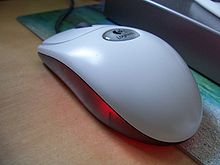Input device
This article does not cite any sources. (October 2018) |
In computing, an input device is a piece of equipment used to provide data and control signals to an information processing system, such as a computer or information appliance. Examples of input devices include keyboards, mouse, scanners, cameras, joysticks, and microphones.
Input devices can be categorized based on:
- modality of input (e.g., mechanical motion, audio, visual, etc.)
- whether the input is discrete (e.g., pressing of key) or continuous (e.g., a mouse's position, though digitized into a discrete quantity, is fast enough to be considered continuous)
- the number of degrees of freedom involved (e.g., two-dimensional traditional mice, or three-dimensional navigators designed for CAD applications)
Keyboard[]
A 'keyboard' is a human interface device which is represented as a layout of buttons. Each button, or key, can be used to either input an alphanumeric character to a computer, or to call upon a particular function of the computer. It acts as the main text entry interface for most users. Traditional keyboards use spring-based buttons, though newer variations employ virtual keys, or even projected keyboards.
Examples of types of keyboards include:
Computer Mouse[]

Mouse are the most commonly used input devices today. A mouse is any human interface device that allows a user to input spatial data to a computer. In the case of mouse and touchpads, this is usually achieved by detecting movement across a physical surface. Analog devices, such as 3D mice, joysticks, or pointing sticks, function by reporting their angle of deflection. Movements of the pointing device are echoed on the screen by movements of the pointer, creating a simple, intuitive way to navigate a computer's graphical user interface (GUI).
Pointing devices, which are input devices used to specify a position in space, can further be classified according to:
- Whether the input is direct or indirect. With direct input, the input space coincides with the display space, i.e. pointing is done in the space where visual feedback or the pointer appears. Touchscreens and light pens involve direct input. Examples involving indirect input include the mouse and trackball.
- Whether the positional information is absolute (e.g. on a touch screen) or relative (e.g., with a mouse that can be lifted and repositioned)
For pointing devices, direct input is almost necessarily absolute, but indirect input may be either absolute or relative. For example, digitizing graphics tablets that do not have an embedded screen involve indirect input and sense absolute positions and are often run in an absolute input mode, but they may also be set up to simulate a relative input mode like that of a touchpad, where the stylus or puck can be lifted and repositioned. which are also referred to as graphics tablet monitors are the extension of digitizing graphics tablets. They enable users to see the real-time positions via the screen while using.
Examples of types of pointing devices include:
High-degree of freedom input devices[]
Some devices allow many continuous degrees of freedom as input. These can be used as pointing devices, but are generally used in ways that don't involve pointing to a location in space, such as the control of a camera angle while in 3D applications. These kinds of devices are typically used in virtual reality systems (CAVEs), where input that registers six degrees of freedom is required.
Composite devices[]

Input devices, such as buttons and joysticks, can be combined on a single physical device that could be thought of as a composite device. Many gaming devices have controllers like this. Technically mice are composite devices, as they both track movement and provide buttons for clicking, but composite devices are generally considered to have more than two different forms of input.
Examples of types of composite devices include:
- Joystick controller
- Gamepad (or joypad)
- Paddle (game controller)
- Jog dial/shuttle (or knob)
- Wii Remote
Video input devices[]

Video input devices are used to digitize images or video from the outside world into the computer. The information can be stored in a multitude of formats depending on the user's requirement.
Examples of types of a video input devices include:
- Digital camera
- Digital camcorder
- Portable media player
- Webcam
- Microsoft Kinect Sensor
- Image scanner
- Fingerprint scanner
- Barcode reader
- 3D scanner
- Laser rangefinder
- Eye gaze tracker
Voice input devices[]
Voice input devices are used to capture sound. In some cases, an audio output device can be used as an input device, in order to capture produced sound. Audio input devices allow a user to send audio info to a computer for processing, recording, or carrying out commands. Devices such as microphones allow users to speak to the computer in order to record a voice message or navigate software. Aside from recording, audio input devices are also used with speech recognition software.
Examples of types of voice input devices include:
- Microphones
- MIDI keyboard or other digital musical instrument
Punched paper[]
Punched cards and punched tapes were much used in the 20th century. A punched hole represented a one; its absence represented a zero. There were mechanical and optical readers.
Other[]
- Gesture recognition
- Digital pen
- Magnetic ink character recognition
- Sip-and-puff#Computer input device
See also[]
- Peripheral
- Display device
Further reading[]
- N. P. Milner. 1988
- A review of human performance and preferences with different input devices to computer systems. In Proceedings of the Fourth Conference of the British Computer Society on People and computers IV, D. M. Jones and R. Winder (Eds.). Cambridge University Press, New York, NY, USA, 341–362. ISBN 0-521-36553-8
- Computing input devices
